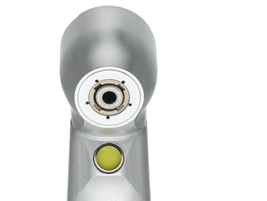A hand piece is that one tool of a dentist that can be rightly said as the extension of his body. Any dentist whether general or specialist needs to own a proper hand piece.
The technology of dental hand pieces are constantly evolving and every time a better and improved version is coming out. So its up to the dentist to choose a hand piece as per his requirements.

But after purchasing, the longevity of the hand piece depends upon if its properly maintained.
A properly maintained hand piece can work properly for a long time there by playing a major role in the success of the practice.
So a few pointers described below can be used to a have a smooth use of your hand piece for a long time.

- First, always follow your manufacturers recommendations for handpiece maintenance. Make sure your handpiece is used at the proper PSI, usually between thirty and forty PSI.
- If you run your handpiece at a higher pressure you will certainly cut the life of your bearings and the chuck. Also running your handpiece with the burr pulled out to gain extra reach will destroy the chuck and bearings very fast.
- Second, wash the outer casing with alcohol or warm water and a soft to medium bristle brush depending on need. Please do not soak the handpiece under water or in any type of chemical. Do not use an ultrasonic cleaner unless recommended by the manufacturer.
See Next Slide
How To Keep Your Hand Piece Clean

- Before we go any further you may want to know a little bit about the technical operation of the high-speed handpiece and how it collects debris.
- The high-speed handpiece pushes air from the the top and bottom of the head. When you let off the air control or rheostat the handpiece will shut down.
- At this time the handpiece draws in fine particulates of dust partials. This is because at the time you let off the air the air flow is reversed bringing in tooth dust and other contaminants.
- If the debris is not removed the contaminants will bake into the turbine and inside the chuck causing premature failure.
Third, choose your lubricant. Sprays are good but they have a propellant that needs to evaporate before the lubricant is left. I use an oil pen or syringe.
For me this is the better way to go because you have direct control of your oil. The oil you use should meet of exceed the manufacturers specifications.
If you use a spray, make sure you have the correct nozzle.
- If you don’t, buy one because you won’t be able to get the oil where it needs to be. Use two or three blasts of one second each into the air hole.
- The air hole is the smaller one of the two hole system and the middle one for the three hole system. If you use an oil pen place three drops into the air hole.
- Use the same procedure for the chuck. One shot of spray or one drop of oil from the oil pen.
- Work the chuck by placing a burr in and out making sure the oil is thoroughly worked in.

www.qudent.co.uk hand piece cleaners
Also the burr must be clean of contaminant. Hook the handpiece back up to the air and run at 20 PSI without the burr for about twenty or thirty seconds over a paper towel. look for the oil to be clear. If not repeat this procedure until it is. Now put in a burr and run for forty seconds at normal air pressure and look for contaminate. If the oil is clean it is time to autoclave.
- Fourth, autoclave as normal. Do not stack handpieces in the autoclave.
- Fifth, after you autoclave spray a one second blast into the air hole and one more into the chuck. One drop each for the oil pen. Hook up to air and run for 30 or forty seconds to purge the last of the oil and have a properly running hand piece.
If these basic steps are followed then hundreds of rupees can be saved every year on hand piece repair.
Wish you a happy Dental Practice





